Servant Leadership: An Argumentative Essay on its Superiority
VerifiedAdded on 2023/06/07
|9
|2788
|266
Essay
AI Summary
This essay argues that servant leadership is a superior model compared to traditional autocratic leadership styles. It highlights the importance of leadership in organizations and the evolution of leadership styles over time. Servant leadership, characterized by a focus on teamwork, community building, and individual growth, fosters a positive work culture, enhances coordination, and promotes transparency. The essay also addresses potential drawbacks such as slower decision-making and increased conflicts, while concluding that the benefits of servant leadership, including improved employee engagement, retention, and satisfaction, outweigh its cons, making it a valuable approach for modern organizations. Desklib provides this essay and many other resources for students.

Service leadership is a better model of leadership
Essay
Essay
Paraphrase This Document
Need a fresh take? Get an instant paraphrase of this document with our AI Paraphraser
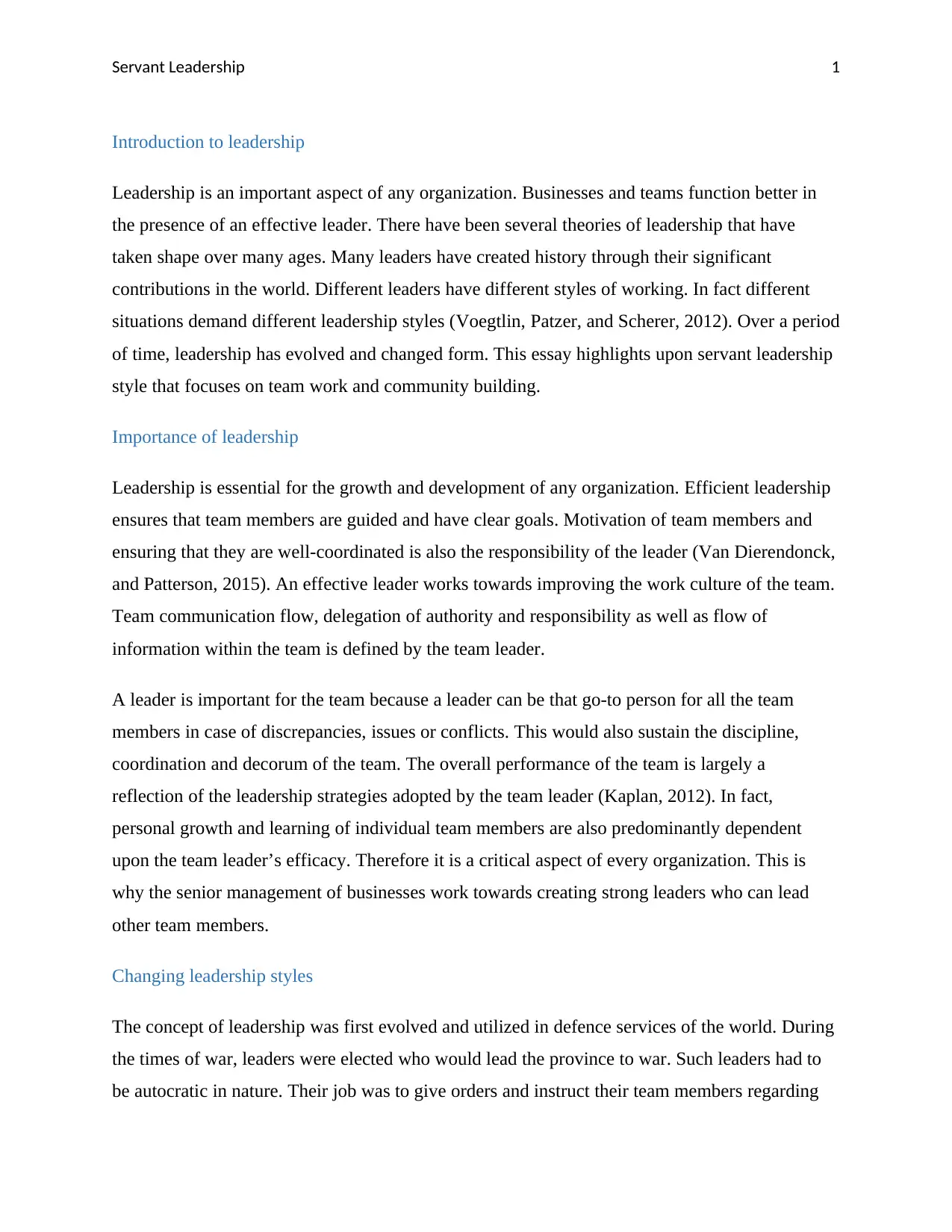
Servant Leadership 1
Introduction to leadership
Leadership is an important aspect of any organization. Businesses and teams function better in
the presence of an effective leader. There have been several theories of leadership that have
taken shape over many ages. Many leaders have created history through their significant
contributions in the world. Different leaders have different styles of working. In fact different
situations demand different leadership styles (Voegtlin, Patzer, and Scherer, 2012). Over a period
of time, leadership has evolved and changed form. This essay highlights upon servant leadership
style that focuses on team work and community building.
Importance of leadership
Leadership is essential for the growth and development of any organization. Efficient leadership
ensures that team members are guided and have clear goals. Motivation of team members and
ensuring that they are well-coordinated is also the responsibility of the leader (Van Dierendonck,
and Patterson, 2015). An effective leader works towards improving the work culture of the team.
Team communication flow, delegation of authority and responsibility as well as flow of
information within the team is defined by the team leader.
A leader is important for the team because a leader can be that go-to person for all the team
members in case of discrepancies, issues or conflicts. This would also sustain the discipline,
coordination and decorum of the team. The overall performance of the team is largely a
reflection of the leadership strategies adopted by the team leader (Kaplan, 2012). In fact,
personal growth and learning of individual team members are also predominantly dependent
upon the team leader’s efficacy. Therefore it is a critical aspect of every organization. This is
why the senior management of businesses work towards creating strong leaders who can lead
other team members.
Changing leadership styles
The concept of leadership was first evolved and utilized in defence services of the world. During
the times of war, leaders were elected who would lead the province to war. Such leaders had to
be autocratic in nature. Their job was to give orders and instruct their team members regarding
Introduction to leadership
Leadership is an important aspect of any organization. Businesses and teams function better in
the presence of an effective leader. There have been several theories of leadership that have
taken shape over many ages. Many leaders have created history through their significant
contributions in the world. Different leaders have different styles of working. In fact different
situations demand different leadership styles (Voegtlin, Patzer, and Scherer, 2012). Over a period
of time, leadership has evolved and changed form. This essay highlights upon servant leadership
style that focuses on team work and community building.
Importance of leadership
Leadership is essential for the growth and development of any organization. Efficient leadership
ensures that team members are guided and have clear goals. Motivation of team members and
ensuring that they are well-coordinated is also the responsibility of the leader (Van Dierendonck,
and Patterson, 2015). An effective leader works towards improving the work culture of the team.
Team communication flow, delegation of authority and responsibility as well as flow of
information within the team is defined by the team leader.
A leader is important for the team because a leader can be that go-to person for all the team
members in case of discrepancies, issues or conflicts. This would also sustain the discipline,
coordination and decorum of the team. The overall performance of the team is largely a
reflection of the leadership strategies adopted by the team leader (Kaplan, 2012). In fact,
personal growth and learning of individual team members are also predominantly dependent
upon the team leader’s efficacy. Therefore it is a critical aspect of every organization. This is
why the senior management of businesses work towards creating strong leaders who can lead
other team members.
Changing leadership styles
The concept of leadership was first evolved and utilized in defence services of the world. During
the times of war, leaders were elected who would lead the province to war. Such leaders had to
be autocratic in nature. Their job was to give orders and instruct their team members regarding

Servant Leadership 2
their future course of action. Over a period of time, this leadership style was adopted in business
organizations. Such a leadership style had its own set of advantages. For example, time was
efficiently utilized and decision making was much quicker (Raelin, 2011). Teams also did not
face many conflicts as individual opinions were not considered important. However, the problem
with such a leadership was that it helped in the growth of one leader whereas other members of
the team had restricted learning and bounded innovation.
Gradually, this leadership style evolved and leaders adopted a more participative approach
towards their teams. In the present days, leaders work towards enhancing the levels of
participation from team members and enhance coordination among all stakeholders of the team.
This leadership style distributes responsibility among all team members, decisions are made after
mutual discussions and creativity is fostered through encouragement (Chen, Zhu, and Zhou
2015). A democratic and participative leadership style also works towards enhancing a sense of
ownership that team members have towards the organization (Bush, 2012). Such leaderships
result in increased coordination and improved performance of the organization at large.
Servant leadership
The term servant leadership was first coined by Robert K. Greenleaf in 1970. The idea behind
this leadership style is that a leader is a servant first (Choudhary et. al., 2013). The feeling to
serve others comes naturally and aims at the leaders putting conscious efforts to serve their
respective teams. Servant leaders focuses on the growth and development of the team,
organization and community that envelops them. The major difference between traditional
leadership and servant leadership is the willingness of traditional leaders to exercise their power
on their team members as opposed to the willingness of servant leaders to serve their team
members and ensure their growth (Liden et. al., 2014).
Servant leadership is being largely adopted by various leaders across the globe owing to its
immensely positive longer term impact on the organization. Servant leaders are respected and
trusted by the virtue of their attitude and behaviour towards their team rather than their positional
designation. There are various advantages to this form of leadership which are discussed as
below.
their future course of action. Over a period of time, this leadership style was adopted in business
organizations. Such a leadership style had its own set of advantages. For example, time was
efficiently utilized and decision making was much quicker (Raelin, 2011). Teams also did not
face many conflicts as individual opinions were not considered important. However, the problem
with such a leadership was that it helped in the growth of one leader whereas other members of
the team had restricted learning and bounded innovation.
Gradually, this leadership style evolved and leaders adopted a more participative approach
towards their teams. In the present days, leaders work towards enhancing the levels of
participation from team members and enhance coordination among all stakeholders of the team.
This leadership style distributes responsibility among all team members, decisions are made after
mutual discussions and creativity is fostered through encouragement (Chen, Zhu, and Zhou
2015). A democratic and participative leadership style also works towards enhancing a sense of
ownership that team members have towards the organization (Bush, 2012). Such leaderships
result in increased coordination and improved performance of the organization at large.
Servant leadership
The term servant leadership was first coined by Robert K. Greenleaf in 1970. The idea behind
this leadership style is that a leader is a servant first (Choudhary et. al., 2013). The feeling to
serve others comes naturally and aims at the leaders putting conscious efforts to serve their
respective teams. Servant leaders focuses on the growth and development of the team,
organization and community that envelops them. The major difference between traditional
leadership and servant leadership is the willingness of traditional leaders to exercise their power
on their team members as opposed to the willingness of servant leaders to serve their team
members and ensure their growth (Liden et. al., 2014).
Servant leadership is being largely adopted by various leaders across the globe owing to its
immensely positive longer term impact on the organization. Servant leaders are respected and
trusted by the virtue of their attitude and behaviour towards their team rather than their positional
designation. There are various advantages to this form of leadership which are discussed as
below.
⊘ This is a preview!⊘
Do you want full access?
Subscribe today to unlock all pages.

Trusted by 1+ million students worldwide

Servant Leadership 3
Team work and coordination
A servant leader would work towards enhancing the level of coordination and team work in the
organization. Since the servant leader is not inclined towards exercising power and giving
instructions, the entire team works in coordination and participates in order to device a course of
action (Reed et. al., 2011). This leads to improved communication among all team members and
helps them achieve their goals through mutual understanding and team work. Servant leadership
also opens doors to team communication and helps increasing the frequency as well as the
transparency of the communication that is held within the team among all stakeholders. In the
longer run, this creates and fosters positive interrelationships among team members.
Individual growth and future leadership
Autocratic leadership enabled quick decision making and fewer conflicts among team members.
But at the same time, all the instructions traversed from the leader to the rest of the team making
it almost impossible for team members to foster any form of creativity or enable personal
learning (Black, 2013). Team members working under servant leadership are actively involved in
the team discussions and decisions making it plausible for them to enhance their own learning
and development. This makes them more eligible for professional growth. Due to improved
communication strategies adopted by the servant leader, members of the team find it easier to
communicate with others and address their issues or problems thereby enabling improved
learning.
Creativity and innovation
When a group of people are encouraged to participate in group decisions, they can think out of
box as opposed to when they are given instructions that must be followed as deemed by the
leader. Therefore a servant leadership style which is highly participative in nature tends to foster
creativity and innovation among team members by providing them with opportunities to use their
creative bent of mind and come up with new ideas. The high level of coordination devised by the
servant leader also ensures that all team members encourage each other to share their opinions
and hence foster their creativity (Peterson et. al., 2012). Creativity within team members need
fuel to grow and this is exactly what servant leadership offers to its team members. An effective
Team work and coordination
A servant leader would work towards enhancing the level of coordination and team work in the
organization. Since the servant leader is not inclined towards exercising power and giving
instructions, the entire team works in coordination and participates in order to device a course of
action (Reed et. al., 2011). This leads to improved communication among all team members and
helps them achieve their goals through mutual understanding and team work. Servant leadership
also opens doors to team communication and helps increasing the frequency as well as the
transparency of the communication that is held within the team among all stakeholders. In the
longer run, this creates and fosters positive interrelationships among team members.
Individual growth and future leadership
Autocratic leadership enabled quick decision making and fewer conflicts among team members.
But at the same time, all the instructions traversed from the leader to the rest of the team making
it almost impossible for team members to foster any form of creativity or enable personal
learning (Black, 2013). Team members working under servant leadership are actively involved in
the team discussions and decisions making it plausible for them to enhance their own learning
and development. This makes them more eligible for professional growth. Due to improved
communication strategies adopted by the servant leader, members of the team find it easier to
communicate with others and address their issues or problems thereby enabling improved
learning.
Creativity and innovation
When a group of people are encouraged to participate in group decisions, they can think out of
box as opposed to when they are given instructions that must be followed as deemed by the
leader. Therefore a servant leadership style which is highly participative in nature tends to foster
creativity and innovation among team members by providing them with opportunities to use their
creative bent of mind and come up with new ideas. The high level of coordination devised by the
servant leader also ensures that all team members encourage each other to share their opinions
and hence foster their creativity (Peterson et. al., 2012). Creativity within team members need
fuel to grow and this is exactly what servant leadership offers to its team members. An effective
Paraphrase This Document
Need a fresh take? Get an instant paraphrase of this document with our AI Paraphraser
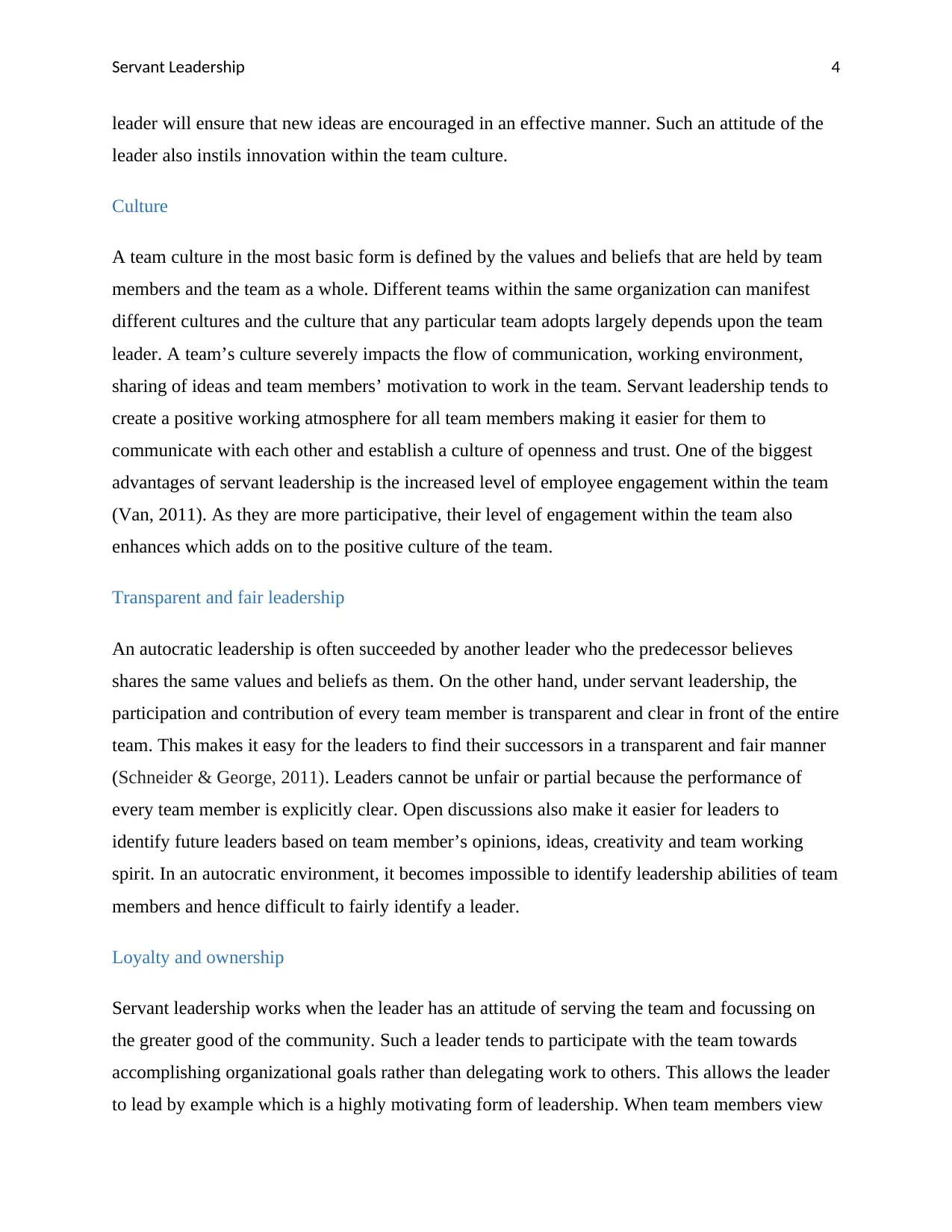
Servant Leadership 4
leader will ensure that new ideas are encouraged in an effective manner. Such an attitude of the
leader also instils innovation within the team culture.
Culture
A team culture in the most basic form is defined by the values and beliefs that are held by team
members and the team as a whole. Different teams within the same organization can manifest
different cultures and the culture that any particular team adopts largely depends upon the team
leader. A team’s culture severely impacts the flow of communication, working environment,
sharing of ideas and team members’ motivation to work in the team. Servant leadership tends to
create a positive working atmosphere for all team members making it easier for them to
communicate with each other and establish a culture of openness and trust. One of the biggest
advantages of servant leadership is the increased level of employee engagement within the team
(Van, 2011). As they are more participative, their level of engagement within the team also
enhances which adds on to the positive culture of the team.
Transparent and fair leadership
An autocratic leadership is often succeeded by another leader who the predecessor believes
shares the same values and beliefs as them. On the other hand, under servant leadership, the
participation and contribution of every team member is transparent and clear in front of the entire
team. This makes it easy for the leaders to find their successors in a transparent and fair manner
(Schneider & George, 2011). Leaders cannot be unfair or partial because the performance of
every team member is explicitly clear. Open discussions also make it easier for leaders to
identify future leaders based on team member’s opinions, ideas, creativity and team working
spirit. In an autocratic environment, it becomes impossible to identify leadership abilities of team
members and hence difficult to fairly identify a leader.
Loyalty and ownership
Servant leadership works when the leader has an attitude of serving the team and focussing on
the greater good of the community. Such a leader tends to participate with the team towards
accomplishing organizational goals rather than delegating work to others. This allows the leader
to lead by example which is a highly motivating form of leadership. When team members view
leader will ensure that new ideas are encouraged in an effective manner. Such an attitude of the
leader also instils innovation within the team culture.
Culture
A team culture in the most basic form is defined by the values and beliefs that are held by team
members and the team as a whole. Different teams within the same organization can manifest
different cultures and the culture that any particular team adopts largely depends upon the team
leader. A team’s culture severely impacts the flow of communication, working environment,
sharing of ideas and team members’ motivation to work in the team. Servant leadership tends to
create a positive working atmosphere for all team members making it easier for them to
communicate with each other and establish a culture of openness and trust. One of the biggest
advantages of servant leadership is the increased level of employee engagement within the team
(Van, 2011). As they are more participative, their level of engagement within the team also
enhances which adds on to the positive culture of the team.
Transparent and fair leadership
An autocratic leadership is often succeeded by another leader who the predecessor believes
shares the same values and beliefs as them. On the other hand, under servant leadership, the
participation and contribution of every team member is transparent and clear in front of the entire
team. This makes it easy for the leaders to find their successors in a transparent and fair manner
(Schneider & George, 2011). Leaders cannot be unfair or partial because the performance of
every team member is explicitly clear. Open discussions also make it easier for leaders to
identify future leaders based on team member’s opinions, ideas, creativity and team working
spirit. In an autocratic environment, it becomes impossible to identify leadership abilities of team
members and hence difficult to fairly identify a leader.
Loyalty and ownership
Servant leadership works when the leader has an attitude of serving the team and focussing on
the greater good of the community. Such a leader tends to participate with the team towards
accomplishing organizational goals rather than delegating work to others. This allows the leader
to lead by example which is a highly motivating form of leadership. When team members view
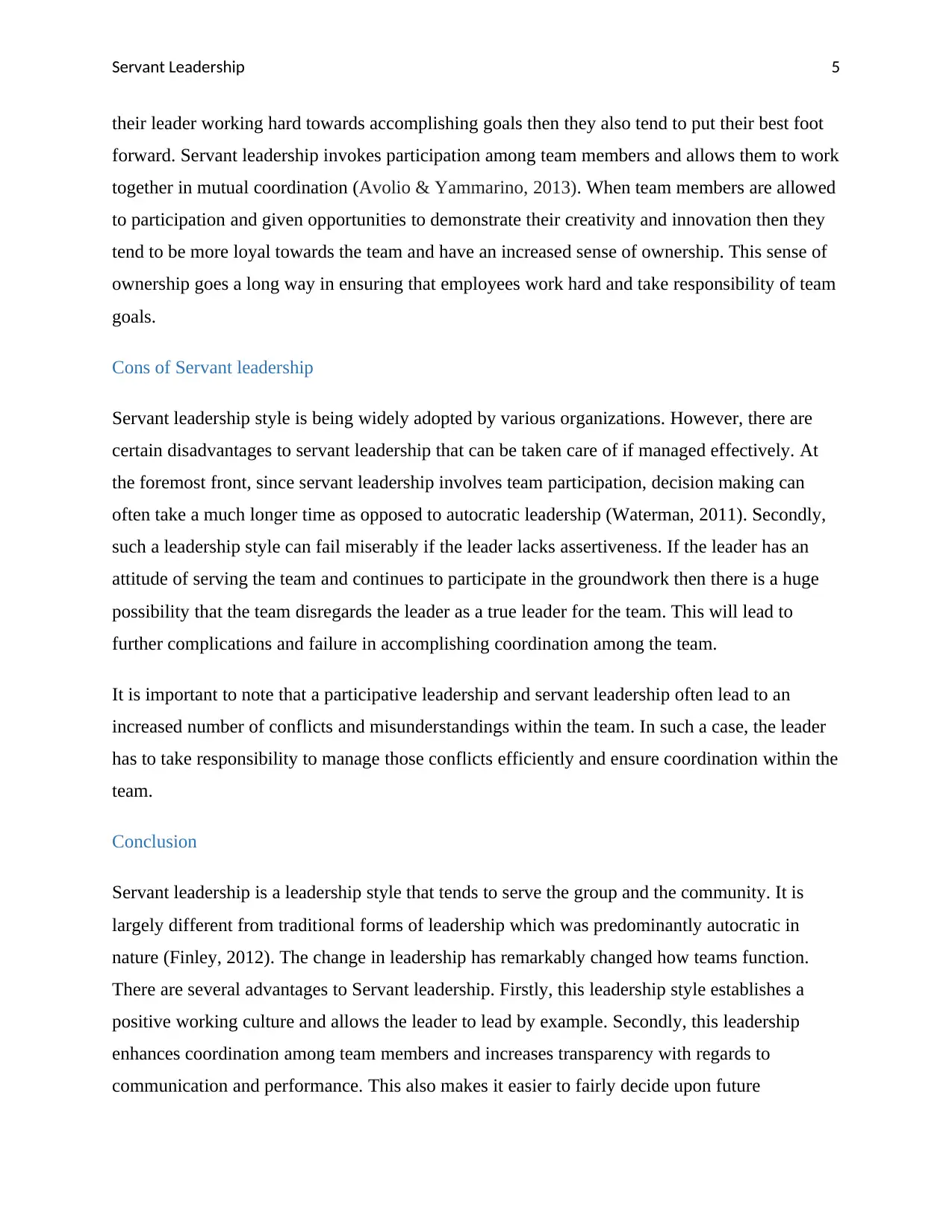
Servant Leadership 5
their leader working hard towards accomplishing goals then they also tend to put their best foot
forward. Servant leadership invokes participation among team members and allows them to work
together in mutual coordination (Avolio & Yammarino, 2013). When team members are allowed
to participation and given opportunities to demonstrate their creativity and innovation then they
tend to be more loyal towards the team and have an increased sense of ownership. This sense of
ownership goes a long way in ensuring that employees work hard and take responsibility of team
goals.
Cons of Servant leadership
Servant leadership style is being widely adopted by various organizations. However, there are
certain disadvantages to servant leadership that can be taken care of if managed effectively. At
the foremost front, since servant leadership involves team participation, decision making can
often take a much longer time as opposed to autocratic leadership (Waterman, 2011). Secondly,
such a leadership style can fail miserably if the leader lacks assertiveness. If the leader has an
attitude of serving the team and continues to participate in the groundwork then there is a huge
possibility that the team disregards the leader as a true leader for the team. This will lead to
further complications and failure in accomplishing coordination among the team.
It is important to note that a participative leadership and servant leadership often lead to an
increased number of conflicts and misunderstandings within the team. In such a case, the leader
has to take responsibility to manage those conflicts efficiently and ensure coordination within the
team.
Conclusion
Servant leadership is a leadership style that tends to serve the group and the community. It is
largely different from traditional forms of leadership which was predominantly autocratic in
nature (Finley, 2012). The change in leadership has remarkably changed how teams function.
There are several advantages to Servant leadership. Firstly, this leadership style establishes a
positive working culture and allows the leader to lead by example. Secondly, this leadership
enhances coordination among team members and increases transparency with regards to
communication and performance. This also makes it easier to fairly decide upon future
their leader working hard towards accomplishing goals then they also tend to put their best foot
forward. Servant leadership invokes participation among team members and allows them to work
together in mutual coordination (Avolio & Yammarino, 2013). When team members are allowed
to participation and given opportunities to demonstrate their creativity and innovation then they
tend to be more loyal towards the team and have an increased sense of ownership. This sense of
ownership goes a long way in ensuring that employees work hard and take responsibility of team
goals.
Cons of Servant leadership
Servant leadership style is being widely adopted by various organizations. However, there are
certain disadvantages to servant leadership that can be taken care of if managed effectively. At
the foremost front, since servant leadership involves team participation, decision making can
often take a much longer time as opposed to autocratic leadership (Waterman, 2011). Secondly,
such a leadership style can fail miserably if the leader lacks assertiveness. If the leader has an
attitude of serving the team and continues to participate in the groundwork then there is a huge
possibility that the team disregards the leader as a true leader for the team. This will lead to
further complications and failure in accomplishing coordination among the team.
It is important to note that a participative leadership and servant leadership often lead to an
increased number of conflicts and misunderstandings within the team. In such a case, the leader
has to take responsibility to manage those conflicts efficiently and ensure coordination within the
team.
Conclusion
Servant leadership is a leadership style that tends to serve the group and the community. It is
largely different from traditional forms of leadership which was predominantly autocratic in
nature (Finley, 2012). The change in leadership has remarkably changed how teams function.
There are several advantages to Servant leadership. Firstly, this leadership style establishes a
positive working culture and allows the leader to lead by example. Secondly, this leadership
enhances coordination among team members and increases transparency with regards to
communication and performance. This also makes it easier to fairly decide upon future
⊘ This is a preview!⊘
Do you want full access?
Subscribe today to unlock all pages.

Trusted by 1+ million students worldwide
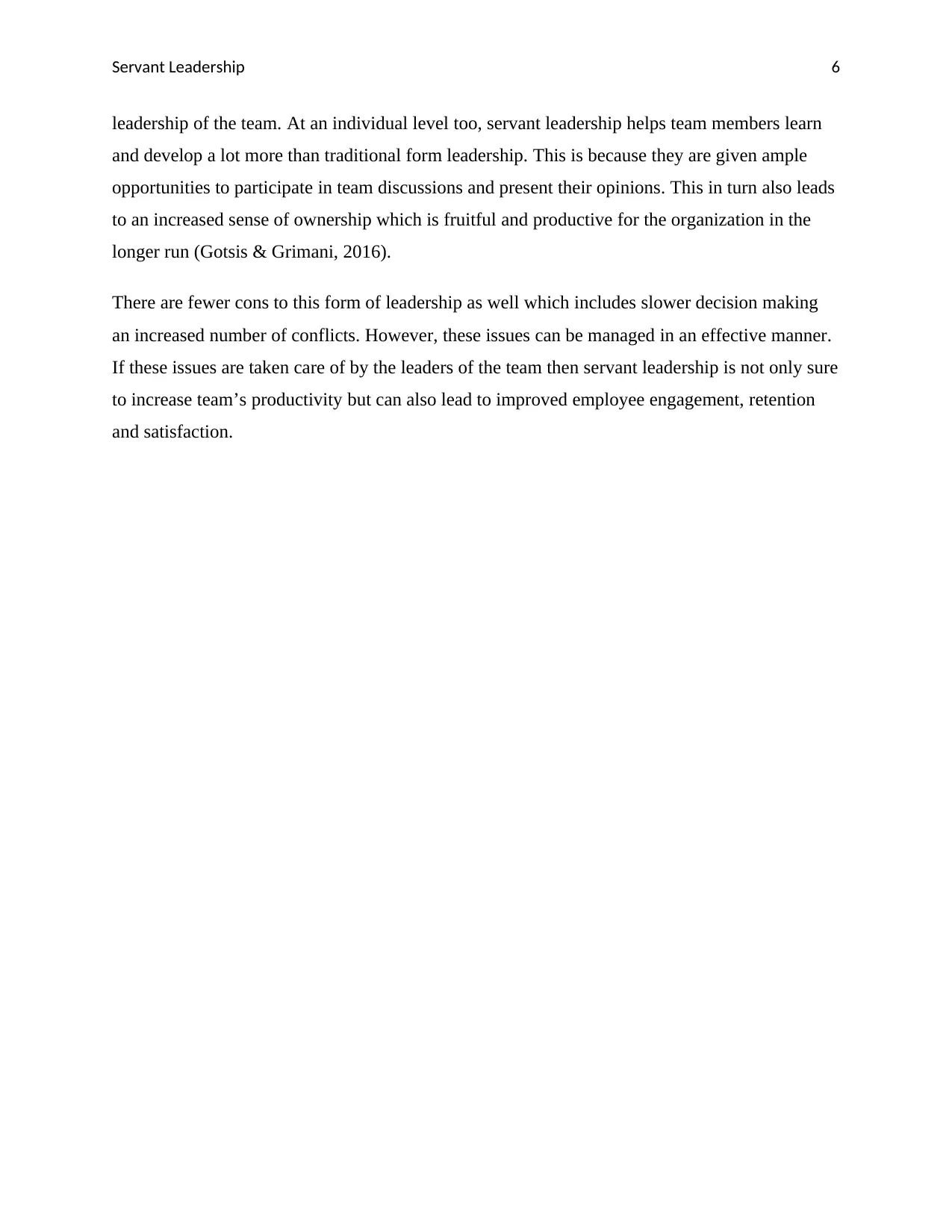
Servant Leadership 6
leadership of the team. At an individual level too, servant leadership helps team members learn
and develop a lot more than traditional form leadership. This is because they are given ample
opportunities to participate in team discussions and present their opinions. This in turn also leads
to an increased sense of ownership which is fruitful and productive for the organization in the
longer run (Gotsis & Grimani, 2016).
There are fewer cons to this form of leadership as well which includes slower decision making
an increased number of conflicts. However, these issues can be managed in an effective manner.
If these issues are taken care of by the leaders of the team then servant leadership is not only sure
to increase team’s productivity but can also lead to improved employee engagement, retention
and satisfaction.
leadership of the team. At an individual level too, servant leadership helps team members learn
and develop a lot more than traditional form leadership. This is because they are given ample
opportunities to participate in team discussions and present their opinions. This in turn also leads
to an increased sense of ownership which is fruitful and productive for the organization in the
longer run (Gotsis & Grimani, 2016).
There are fewer cons to this form of leadership as well which includes slower decision making
an increased number of conflicts. However, these issues can be managed in an effective manner.
If these issues are taken care of by the leaders of the team then servant leadership is not only sure
to increase team’s productivity but can also lead to improved employee engagement, retention
and satisfaction.
Paraphrase This Document
Need a fresh take? Get an instant paraphrase of this document with our AI Paraphraser
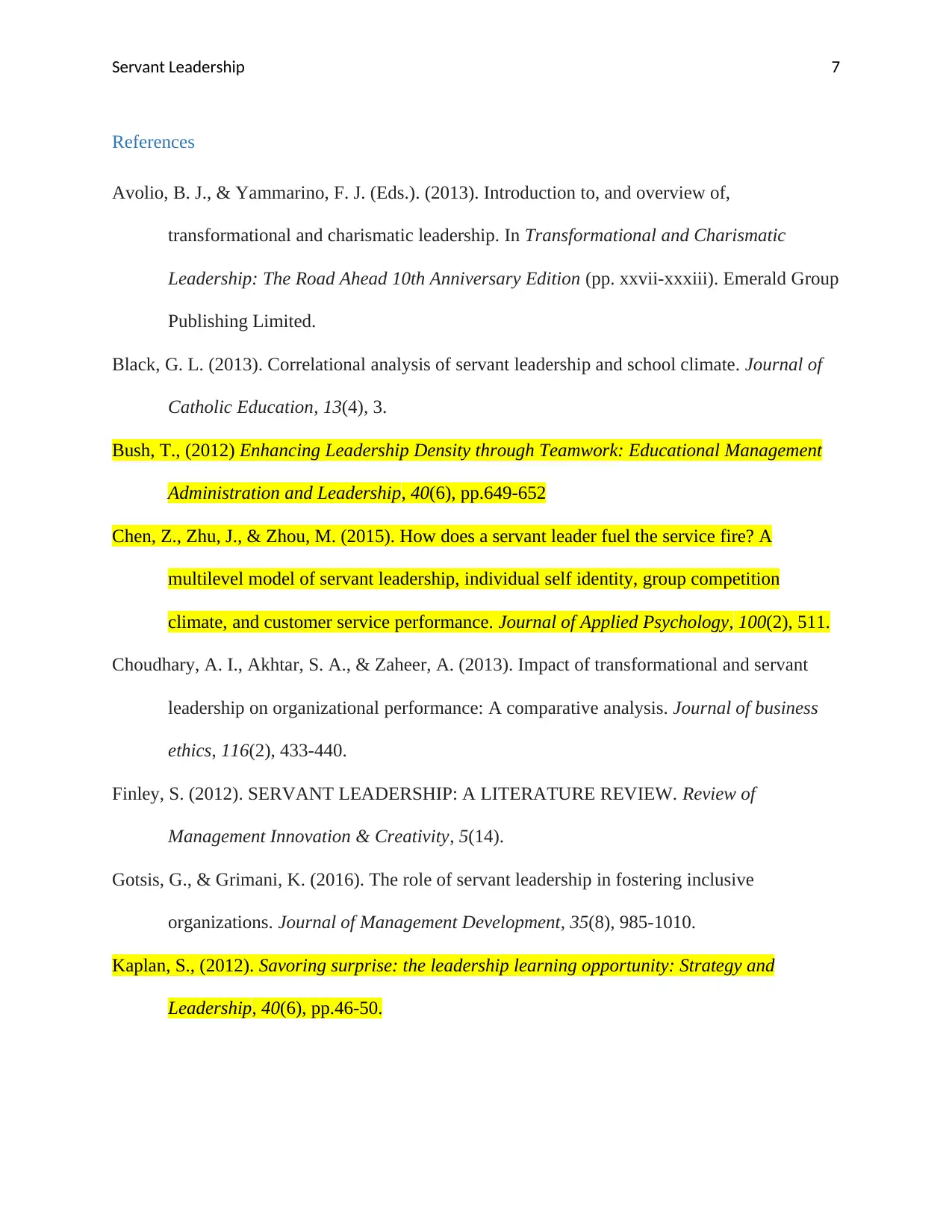
Servant Leadership 7
References
Avolio, B. J., & Yammarino, F. J. (Eds.). (2013). Introduction to, and overview of,
transformational and charismatic leadership. In Transformational and Charismatic
Leadership: The Road Ahead 10th Anniversary Edition (pp. xxvii-xxxiii). Emerald Group
Publishing Limited.
Black, G. L. (2013). Correlational analysis of servant leadership and school climate. Journal of
Catholic Education, 13(4), 3.
Bush, T., (2012) Enhancing Leadership Density through Teamwork: Educational Management
Administration and Leadership, 40(6), pp.649-652
Chen, Z., Zhu, J., & Zhou, M. (2015). How does a servant leader fuel the service fire? A
multilevel model of servant leadership, individual self identity, group competition
climate, and customer service performance. Journal of Applied Psychology, 100(2), 511.
Choudhary, A. I., Akhtar, S. A., & Zaheer, A. (2013). Impact of transformational and servant
leadership on organizational performance: A comparative analysis. Journal of business
ethics, 116(2), 433-440.
Finley, S. (2012). SERVANT LEADERSHIP: A LITERATURE REVIEW. Review of
Management Innovation & Creativity, 5(14).
Gotsis, G., & Grimani, K. (2016). The role of servant leadership in fostering inclusive
organizations. Journal of Management Development, 35(8), 985-1010.
Kaplan, S., (2012). Savoring surprise: the leadership learning opportunity: Strategy and
Leadership, 40(6), pp.46-50.
References
Avolio, B. J., & Yammarino, F. J. (Eds.). (2013). Introduction to, and overview of,
transformational and charismatic leadership. In Transformational and Charismatic
Leadership: The Road Ahead 10th Anniversary Edition (pp. xxvii-xxxiii). Emerald Group
Publishing Limited.
Black, G. L. (2013). Correlational analysis of servant leadership and school climate. Journal of
Catholic Education, 13(4), 3.
Bush, T., (2012) Enhancing Leadership Density through Teamwork: Educational Management
Administration and Leadership, 40(6), pp.649-652
Chen, Z., Zhu, J., & Zhou, M. (2015). How does a servant leader fuel the service fire? A
multilevel model of servant leadership, individual self identity, group competition
climate, and customer service performance. Journal of Applied Psychology, 100(2), 511.
Choudhary, A. I., Akhtar, S. A., & Zaheer, A. (2013). Impact of transformational and servant
leadership on organizational performance: A comparative analysis. Journal of business
ethics, 116(2), 433-440.
Finley, S. (2012). SERVANT LEADERSHIP: A LITERATURE REVIEW. Review of
Management Innovation & Creativity, 5(14).
Gotsis, G., & Grimani, K. (2016). The role of servant leadership in fostering inclusive
organizations. Journal of Management Development, 35(8), 985-1010.
Kaplan, S., (2012). Savoring surprise: the leadership learning opportunity: Strategy and
Leadership, 40(6), pp.46-50.
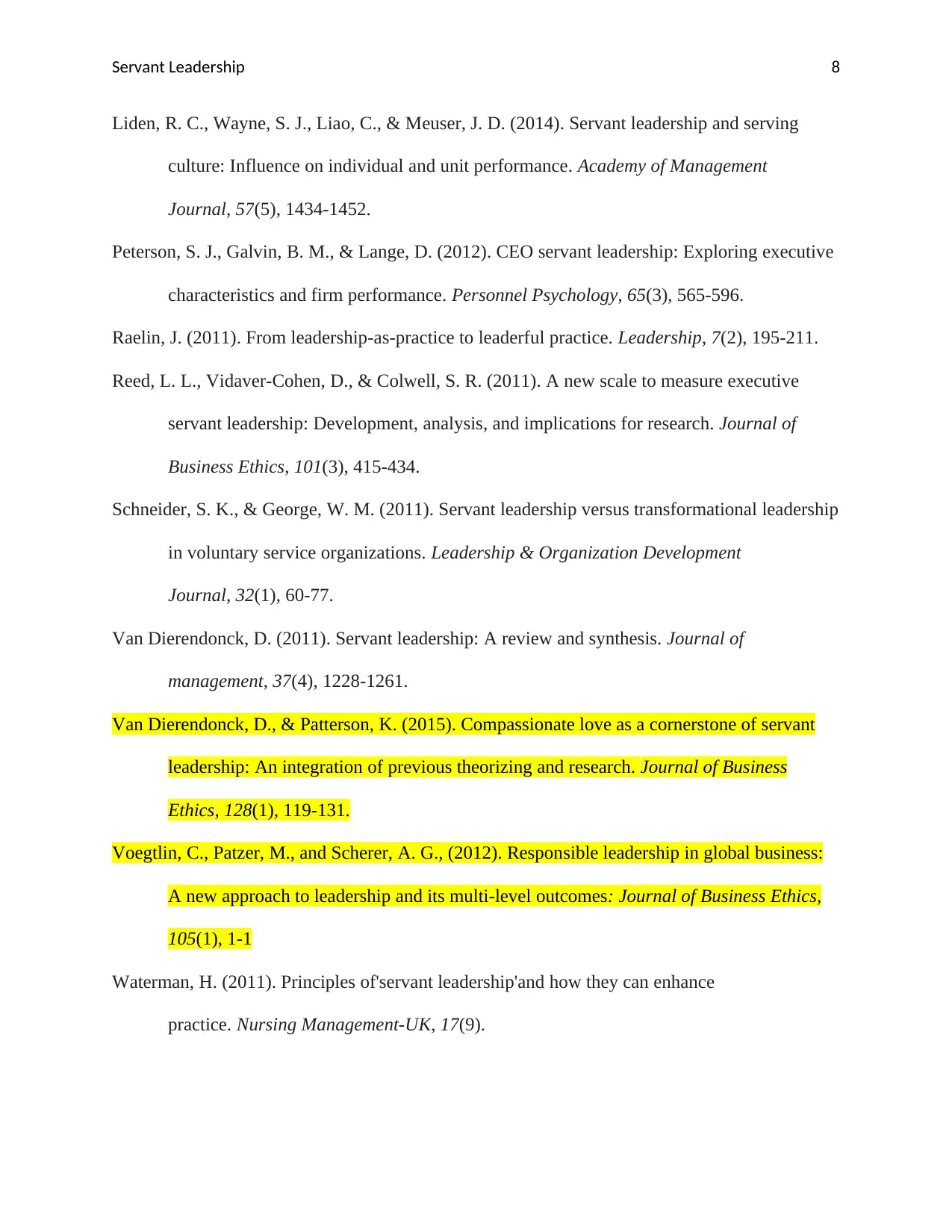
Servant Leadership 8
Liden, R. C., Wayne, S. J., Liao, C., & Meuser, J. D. (2014). Servant leadership and serving
culture: Influence on individual and unit performance. Academy of Management
Journal, 57(5), 1434-1452.
Peterson, S. J., Galvin, B. M., & Lange, D. (2012). CEO servant leadership: Exploring executive
characteristics and firm performance. Personnel Psychology, 65(3), 565-596.
Raelin, J. (2011). From leadership-as-practice to leaderful practice. Leadership, 7(2), 195-211.
Reed, L. L., Vidaver-Cohen, D., & Colwell, S. R. (2011). A new scale to measure executive
servant leadership: Development, analysis, and implications for research. Journal of
Business Ethics, 101(3), 415-434.
Schneider, S. K., & George, W. M. (2011). Servant leadership versus transformational leadership
in voluntary service organizations. Leadership & Organization Development
Journal, 32(1), 60-77.
Van Dierendonck, D. (2011). Servant leadership: A review and synthesis. Journal of
management, 37(4), 1228-1261.
Van Dierendonck, D., & Patterson, K. (2015). Compassionate love as a cornerstone of servant
leadership: An integration of previous theorizing and research. Journal of Business
Ethics, 128(1), 119-131.
Voegtlin, C., Patzer, M., and Scherer, A. G., (2012). Responsible leadership in global business:
A new approach to leadership and its multi-level outcomes: Journal of Business Ethics,
105(1), 1-1
Waterman, H. (2011). Principles of'servant leadership'and how they can enhance
practice. Nursing Management-UK, 17(9).
Liden, R. C., Wayne, S. J., Liao, C., & Meuser, J. D. (2014). Servant leadership and serving
culture: Influence on individual and unit performance. Academy of Management
Journal, 57(5), 1434-1452.
Peterson, S. J., Galvin, B. M., & Lange, D. (2012). CEO servant leadership: Exploring executive
characteristics and firm performance. Personnel Psychology, 65(3), 565-596.
Raelin, J. (2011). From leadership-as-practice to leaderful practice. Leadership, 7(2), 195-211.
Reed, L. L., Vidaver-Cohen, D., & Colwell, S. R. (2011). A new scale to measure executive
servant leadership: Development, analysis, and implications for research. Journal of
Business Ethics, 101(3), 415-434.
Schneider, S. K., & George, W. M. (2011). Servant leadership versus transformational leadership
in voluntary service organizations. Leadership & Organization Development
Journal, 32(1), 60-77.
Van Dierendonck, D. (2011). Servant leadership: A review and synthesis. Journal of
management, 37(4), 1228-1261.
Van Dierendonck, D., & Patterson, K. (2015). Compassionate love as a cornerstone of servant
leadership: An integration of previous theorizing and research. Journal of Business
Ethics, 128(1), 119-131.
Voegtlin, C., Patzer, M., and Scherer, A. G., (2012). Responsible leadership in global business:
A new approach to leadership and its multi-level outcomes: Journal of Business Ethics,
105(1), 1-1
Waterman, H. (2011). Principles of'servant leadership'and how they can enhance
practice. Nursing Management-UK, 17(9).
⊘ This is a preview!⊘
Do you want full access?
Subscribe today to unlock all pages.

Trusted by 1+ million students worldwide
1 out of 9
Related Documents
Your All-in-One AI-Powered Toolkit for Academic Success.
+13062052269
info@desklib.com
Available 24*7 on WhatsApp / Email
![[object Object]](/_next/static/media/star-bottom.7253800d.svg)
Unlock your academic potential
Copyright © 2020–2025 A2Z Services. All Rights Reserved. Developed and managed by ZUCOL.





